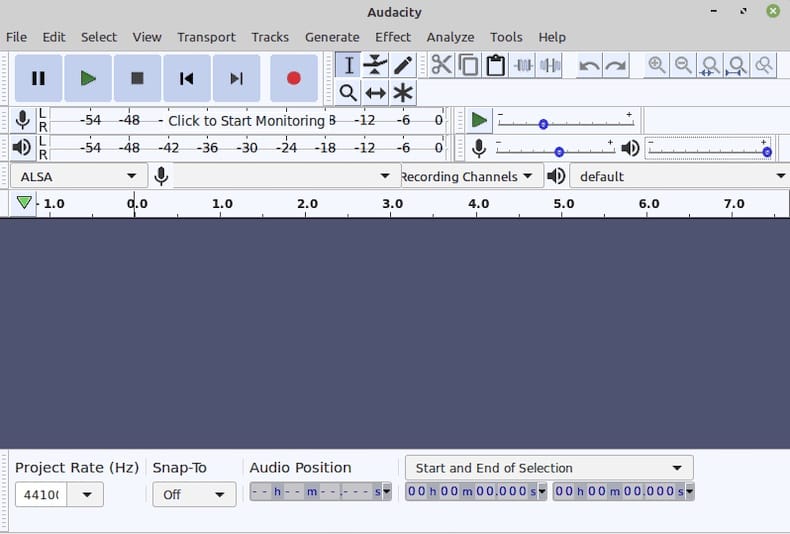How To Install Audacity on AlmaLinux 10

Audacity stands as one of the most powerful and versatile free audio editing software available for Linux systems today. This comprehensive guide will walk you through multiple methods to install Audacity on AlmaLinux 10, ensuring you can choose the approach that best fits your specific needs and technical expertise.
AlmaLinux 10, as a RHEL-based distribution, provides excellent compatibility with various installation methods for Audacity. Whether you’re a podcast creator, musician, or audio professional, having Audacity properly installed on your system opens up a world of audio editing possibilities. From basic recording tasks to advanced multi-track editing, this powerful tool delivers professional-grade features without the hefty price tag.
This guide covers four distinct installation approaches: repository installation, AppImage deployment, Flatpak installation, and manual compilation. Each method offers unique advantages depending on your system requirements and preferences.
Prerequisites and System Requirements
Before diving into the Audacity installation process, ensuring your AlmaLinux 10 system meets the necessary requirements is crucial for optimal performance.
Hardware Requirements
Your system should have at least 2GB of RAM for basic Audacity operations, though 4GB or more is recommended for complex projects with multiple tracks. Disk space requirements vary depending on your projects, but allocate at least 500MB for the application itself and additional space for your audio files.
For optimal performance, consider having a dedicated sound card or audio interface, especially if you plan to record high-quality audio. A multi-core processor will significantly improve rendering and processing times for large audio projects.
Software Prerequisites
Basic familiarity with the Linux command line is essential, as most installation methods require terminal commands. Understanding DNF package management will help you troubleshoot potential issues during installation.
Administrator privileges through sudo access are mandatory for all installation methods except AppImage. Ensure your user account has proper permissions before proceeding.
System Preparation
Proper system preparation forms the foundation for a successful Audacity installation on AlmaLinux 10.
Updating AlmaLinux 10
Begin by updating your system to ensure all packages are current and security patches are applied:
sudo dnf updateThis command refreshes the package database and upgrades all installed packages to their latest versions. The update process may take several minutes depending on your system’s current state and internet connection speed.
Installing Essential Dependencies
Install the core development libraries and audio-related packages that Audacity requires:
sudo dnf install alsa-lib-devel jack-audio-connection-kit-devel libsndfile-devel lv2-devel portaudio-devel soundtouch-devel soxr-devel vamp-plugin-sdk-develThese dependencies provide crucial audio processing capabilities, plugin support, and development libraries necessary for Audacity’s proper functioning.
Installation Method 1: Using AlmaLinux Repositories
The repository installation method offers the most integrated approach to installing Audacity on AlmaLinux 10.
Enabling EPEL Repository
The Extra Packages for Enterprise Linux (EPEL) repository contains additional software packages not included in the standard AlmaLinux repositories. Enable EPEL with this command:
sudo dnf install epel-releaseEPEL provides access to a broader range of software packages, including Audacity and its dependencies. After installation, verify EPEL is properly configured:
sudo dnf repolistInstalling Audacity via DNF
With EPEL enabled, install Audacity using the DNF package manager:
sudo dnf install audacityDNF automatically resolves dependencies and handles the complete installation process. This method typically installs a stable, well-tested version of Audacity that integrates seamlessly with your AlmaLinux system.
Verify the installation by checking the installed version:
audacity --versionPros and Cons of Repository Installation
Advantages include automatic dependency resolution, system integration, and easy updates through the standard package manager. Security updates are handled automatically when you update your system.
Disadvantages may include having an older version compared to the latest Audacity releases, as repository packages often lag behind upstream development.
Installation Method 2: AppImage Installation
AppImage provides a portable way to run Audacity without traditional installation requirements.
Downloading the AppImage
Visit the official Audacity website and download the Linux AppImage version. The download starts automatically after a few seconds on the official site.
Alternatively, you can download from GitHub releases or FossHub, both of which provide verified AppImage files.
Create a dedicated directory for Audacity:
mkdir ~/Audacity
cd ~/AudacityMove the downloaded AppImage file to this directory for better organization.
Making AppImage Executable
The AppImage file requires executable permissions before it can run:
chmod +x <path to your Audacity.AppImage>For GUI users, right-click the AppImage file, select “Properties,” open the “Permissions” tab, and enable “Allow this file to run as a program”.
Running and Troubleshooting AppImage
Launch Audacity by double-clicking the AppImage file or executing it from the terminal:
./Audacity-*.AppImageIf you encounter issues opening the AppImage, install libfuse2:
sudo dnf install fuse-libsAppImage advantages include having the latest Audacity version, no system integration requirements, and portability across different Linux distributions.
Installation Method 3: Flatpak Installation
Flatpak offers a sandboxed environment for running Audacity, providing enhanced security and universal compatibility.
Setting Up Flatpak
Install Flatpak on your AlmaLinux 10 system:
sudo dnf install flatpakAdd the Flathub repository, which hosts the official Audacity Flatpak package:
sudo flatpak remote-add --if-not-exists flathub https://flathub.org/repo/flathub.flatpakrepoRestart your session or reboot your system to ensure Flatpak integration works properly.
Installing Audacity via Flatpak
Install Audacity from the Flathub repository:
sudo flatpak install flathub org.audacityteam.AudacityThe installation process downloads the application and all necessary runtime dependencies within the Flatpak sandbox environment.
Launch Audacity using the Flatpak command:
flatpak run org.audacityteam.AudacityFlatpak Benefits
The sandboxed environment provides enhanced security by isolating Audacity from the rest of your system. Flatpak packages receive updates independently of your system packages, ensuring you have access to the latest features and bug fixes.
Universal package format advantages include consistent behavior across different Linux distributions and simplified dependency management.
Installation Method 4: Manual Compilation
Manual compilation offers the most control over your Audacity installation but requires more technical expertise.
When to Consider Manual Compilation
Choose manual compilation when you need the absolute latest features from Audacity’s development branch, require custom build configurations, or want to contribute to Audacity development.
This method is ideal for developers and advanced users who need specific compile-time options or patches not available in pre-built packages.
Prerequisites for Compilation
Install the build toolchain and development packages:
sudo dnf groupinstall "Development Tools"
sudo dnf install cmake gitInstall additional development libraries specific to Audacity:
sudo dnf install wxGTK3-devel libid3tag-devel libmad-devel libvorbis-devel flac-devel libsndfile-develBasic Compilation Steps
Clone the Audacity source code repository:
git clone https://github.com/audacity/audacity.git
cd audacityConfigure the build environment:
./configureCompile Audacity (this process can take 20+ minutes depending on your system):
makeInstall the compiled application:
sudo make installVerify the installation by running:
audacityPost-Installation Configuration
Proper configuration ensures optimal Audacity performance on your AlmaLinux 10 system.
Initial Setup and Launch
Launch Audacity from the terminal by typing audacity or find it in your application menu under “Sound & Video”. The first launch presents a welcome dialog with initial configuration options.
Configure your preferred language and accept the privacy policy terms. The welcome screen provides quick access to tutorials and documentation for new users.

Audio Device Configuration
Navigate to Edit > Preferences > Devices to configure your audio hardware. Select appropriate input and output devices from the dropdown menus.
For recording, choose your microphone or audio interface in the “Recording Device” section. Set the appropriate number of recording channels (mono or stereo) based on your needs.
Configure playback devices to match your speaker setup or headphones. Test your configuration using the built-in audio test features.
Installing Additional Codecs
Install LAME for MP3 support:
sudo dnf install lameInstall FFmpeg for additional format support:
sudo dnf install ffmpegThese codecs expand Audacity’s import and export capabilities, allowing you to work with a broader range of audio formats including MP3, AAC, and various video formats.
Essential Plugins and Extensions
Extending Audacity’s functionality through plugins enhances its audio processing capabilities.
LADSPA Plugins
Install LADSPA plugin packages for additional audio effects:
sudo dnf install ladspa-pluginsPopular LADSPA plugins include reverb effects, compressors, and specialized audio processors. These plugins integrate seamlessly with Audacity’s effects menu.
Access installed LADSPA plugins through Generate > Plug-in or Effect > Plug-in menus, depending on the plugin type.
Additional Audio Libraries
For VST plugin support, consider installing additional compatibility layers, though native VST support varies by distribution and Audacity version.
Manage plugins through Audacity’s Tools > Plug-in Manager interface, where you can enable, disable, and configure individual plugins.
Install community-developed plugins by downloading them to Audacity’s plugin directories, typically located in ~/.audacity-data/Plug-Ins/.
Troubleshooting Common Issues
Address common installation and runtime problems with these solutions.
Audio Device Problems
If Audacity fails to detect audio devices, check your PulseAudio configuration:
pulseaudio --checkRestart PulseAudio if necessary:
pulseaudio --kill
pulseaudio --startVerify your user belongs to the audio group:
sudo usermod -a -G audio $USERLog out and back in for group changes to take effect.
Installation Errors
Dependency resolution failures often occur when repositories are out of sync. Update your package database:
sudo dnf clean all
sudo dnf makecacheFor repository access issues, verify your internet connection and DNS settings. Check if EPEL repository is properly enabled:
sudo dnf repolist enabledPackage conflicts may require removing conflicting packages or using alternative installation methods.
Performance Issues
Optimize memory usage by adjusting Audacity’s preferences. Navigate to Edit > Preferences > Directories and set appropriate temporary directory locations on fast storage.
Reduce audio latency by configuring buffer sizes in Edit > Preferences > Recording. Smaller buffer sizes reduce latency but may cause audio dropouts on slower systems.
Manage system resources by closing unnecessary applications during intensive audio processing tasks.
Best Practices and Security Considerations
Implement security best practices to maintain a safe and efficient Audacity installation.
Security Best Practices
Keep Audacity updated through your chosen installation method. Repository installations update automatically with system updates, while AppImage and Flatpak installations require manual updates.
Manage user permissions carefully, avoiding unnecessary sudo access for daily Audacity usage. Run Audacity with regular user privileges whenever possible.
Practice safe plugin installation by downloading plugins only from trusted sources. Verify plugin integrity before installation when possible.
Performance Optimization
Optimize your system for audio work by adjusting kernel parameters for low-latency audio processing. Consider using a real-time kernel for professional audio work.
Configure memory and CPU optimization by setting appropriate process priorities and memory limits for Audacity.
Plan storage considerations by keeping audio projects on fast storage devices and maintaining adequate free space for temporary files.
Comparison of Installation Methods
Choose the installation method that best fits your needs based on this comparison.
| Method | Version Currency | System Integration | Update Mechanism | Complexity |
|---|---|---|---|---|
| Repository | Moderate | Excellent | Automatic | Low |
| AppImage | High | Minimal | Manual | Low |
| Flatpak | High | Good | Semi-automatic | Medium |
| Compilation | Highest | Excellent | Manual | High |
Recommendation by Use Case
Repository installation works best for users who prioritize system integration and automatic updates. This method suits most general users who want a stable, maintenance-free Audacity installation.
AppImage installation benefits users who need the latest features without system modification. Ideal for testing new versions or running Audacity on systems where you lack administrator privileges.
Flatpak installation provides a good balance between features and security. Recommended for users who want recent versions with enhanced security through sandboxing.
Manual compilation suits developers and advanced users who need cutting-edge features or custom build configurations.
Congratulations! You have successfully installed Audacity. Thanks for using this tutorial for installing Audacity on your AlmaLinux OS 10 system. For additional help or useful information, we recommend you check the official Audacity website.